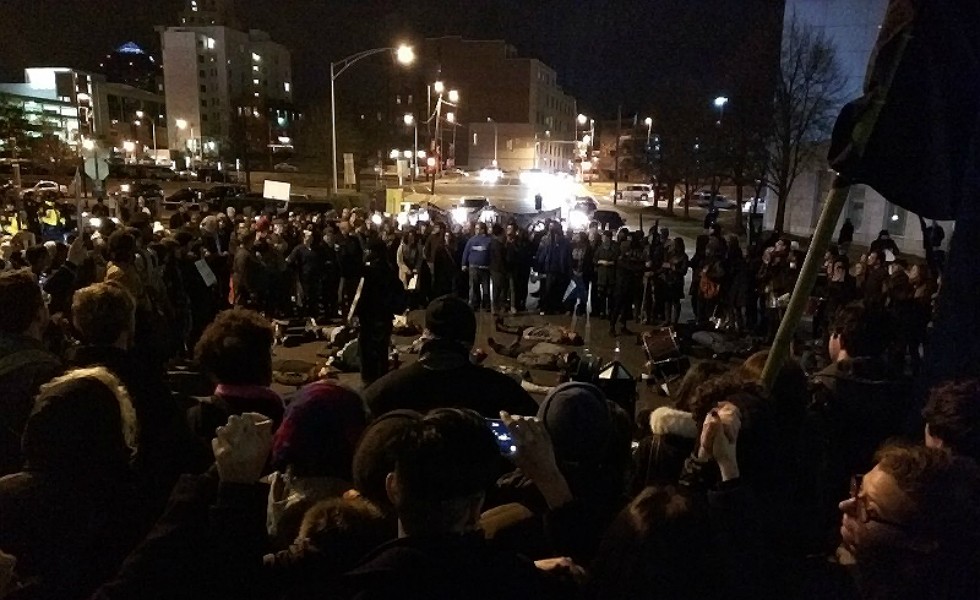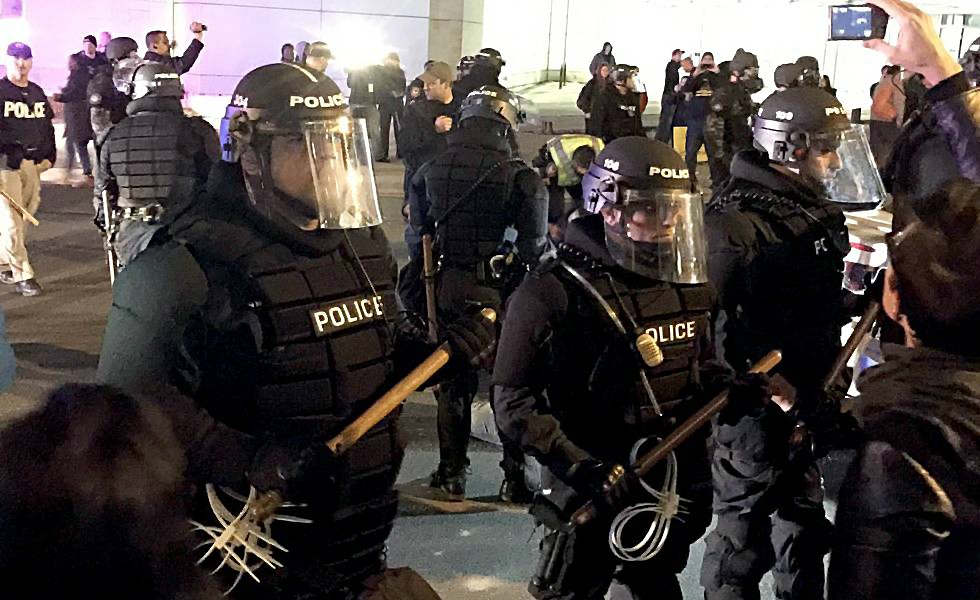Filed under: Police, Publication, Repression, Southeast

From Durham Anti-Repression
Print PDF Here
In the past few years, Durham – like many cities and towns across the U.S. – has seen a pronounced increase in marches, street protests and direct actions. People have come out in large numbers to demonstrate their grief, frustration and rage against police murders and state violence. Protests allow us to come together and develop our capacity to build our own power, but they also can be sites of repression – both from the state and from within. Because DARC opposes repression, we oppose the internal policing of our movements. We hope this document opens up space for dialogue and engagement with each other when we’re not in the streets – so we can be stronger together when we are.
Why do people wear masks? Doesn’t that just give the police a reason to mess with protesters?
People who wear masks are not cowards for covering their faces; they are promoting safety and even helping to increase collective power against the police. Masks help protect people’s faces and lungs from police chemical weapons like tear gas and pepper spray. They also help conceal individual identity while increasing the anonymity of all masked folks. Wearing a mask is a material demonstration of solidarity with other masked folks who may be at higher risk of state repression due to the color of their skin, their status of documentation, or their arrest record. Some mask up because simply being spotted at a political protest could get them fired from their job. Masks interfere with police surveillance and coordinated attacks on individuals believed to be political leaders. By equipping folks with increased anonymity, masks heighten the power of a crowd to claim space in the streets, to drag a fence between the crowd and the cops, to dearrest a comrade by yanking them from police hands, to paint a message to folks locked up in jail, to throw the cops’ canister of tear gas back at them. While masks serve a variety of functions, it’s helpful to remember what masks can’t do: masks alone do not get people arrested. People get arrested because the police exist to arrest people.
What good is it to drag items into the street? Isn’t that just unnecessary hooliganism that distracts from our protest?
Disrupting street traffic with our bodies and with objects blocks the flows of capital that allow our white supremacist prison economy to function. Non-human traffic barricades can hold physical space for us, freeing our bodies to participate in spontaneous forms of protest. We remember the takeovers of NC-147 in the winter of 2014 and the construction fencing that blocked police vehicles from accessing the highway entrance ramp while allowing the continued flow of protesters onto the highway. We also remember that the second takeover of NC-147 spanned many more miles and lasted three times as long. Often we increase the effectiveness of our rebellious tactics simply by practicing them.
Remember, marching in the streets without a permit is illegal! You are probably already breaking the law by participating in street protests. Police often do not make arrests when we march not because they have no grounds for it (which is neither here nor there as police make groundless arrests all the time) but because they are adapting to our patterns of protest. Rather than acquiescing to what the police allow us, we should continue to push these limits. Putting objects in the street is often no more illegal than putting your body there and can help to maintain the rebellious space we’re creating with each other. (Just be sure to place barricades at the tail of the march so as not to physically divide us from each other! )
How do peace marshals contribute to state repression?
Just as there is no single blueprint for social change, there is no single blueprint for protests or demonstrations. At their best, protests should encourage creativity, spontaneity and collective empowerment. Peace marshals, sometimes just called ‘marshals’ or ‘ushers,’ necessarily restrict all of these and promote a culture of passivity rather than self-organization and self-determination. Whether or not they are cooperating or acting in concert with the police, having designated ‘peace keepers’ within our protests complements a police tactic that allows for minor forms of disobedience (for example, blocking a street that can easily be detoured around, or pre-announced civil disobedience) while maintaining a larger objective of crowd control. The presence of marshals signals a desired ‘tone’ for a (typically tightly orchestrated) event, a wish to ‘not cause any trouble.’ The suggestion that marshals help keep protesters ‘safe ’ sounds eerily reminiscent of how the actual police justify themselves. Marshals cannot keep us safe from the police. If we see fewer cops when marshals are present, it is because the march has already been tamed from the outset, and police know and can count on this. It’s also important to remember that not seeing uniformed cops does not mean a lack of police presence — there are often armed undercover cops among us at protests.
Then how can we keep ourselves and each other safe in a protest?
In a world with police there are no safe spaces. Still, there are many ways that people have kept each other safer in the streets without doing the police’s job for them. Some of these include using both soft (fabric) and hard (typically wooden) banners to prevent police from entering a march, having scouts on bicycles report police activity back to the main crowd, coming to a demonstration with a trusted group of friends with their own plans for both action and dispersal, holding regular street medic trainings, erecting barricades to disrupt police movement, and de-arresting people who’ve been grabbed by the cops. Building our power at demonstrations requires us to do more than just follow orders coming from a bullhorn, but to actually develop a culture of resistance to which we all share responsibility.
Let us remember that our enemy is the police, not each other. We remember the woman screaming “Peace!” as she futilely pulled backward on a piece of fencing that others were dragging into the highway to, in the interest of actual safety, slow down speeding traffic during the first takeover of NC-147. We recall those who screamed at and physically pushed protesters out of Durham streets on May Day 2012. Rather than aid the police in their mission of repression, let us converge in the streets to form new relationships, develop our tactics of rebellion, and share stories of grief and rage and hope. Let us seek to shut down the systems of domination and oppression that perpetuate this white supremacist state rather than shutting down each other and our attempts toward liberation. If we do have a hope of creating a safer world for us all, that hope rests on our ability to take care of and support each other in times of revolt.
Some Suggested Readings:
“Hey, Step Back with the Riot Shaming,” by Tyler Reinhard (Aug. 2014)
Unfinished Acts 2.0: January Rebellions, Oakland, CA (2009, revised 2012)






